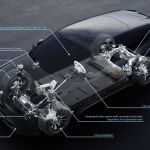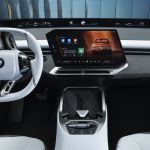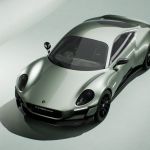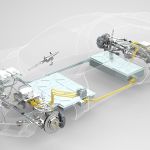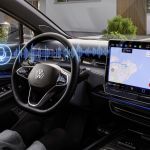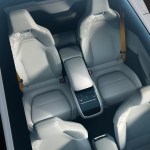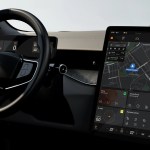NODAR, the Somerville, MA-based provider of multi-camera 3D vision technology, announced today that it has secured a $1.67 million SBIR (Small Business Innovation Research) Phase II contract with the U.S. Army to develop 3D vision systems for military off-road autonomous ground vehicles. Rather than detecting pedestrians, traffic signs, and signals as it is developing for passenger vehicles, NODAR’s Hammerhead technology will be used by the Army to sense terrain, vegetation, and other off-road obstacles in degraded visual environments that have low or no light, dust, smoke, rain, or other harsh conditions.
“NODAR is unique in our ability to provide long-range, high-resolution, real-time 3D sensing using independently mounted cameras while remaining resilient to unfriendly environmental conditions,” said Leaf Jiang, Co-founder & Chief Executive Officer at NODAR. “NODAR’s 3D vision system produces dense 3D point clouds with highly accurate distance estimates to each pixel in the scene. These data provide the detail needed to navigate through difficult terrain and around obstacles.”
The company’s long-range vision system can sense up to 1000 m (3280 ft), which allows it to detect hidden threats long before the vehicle enters the area. To achieve this, NODAR mounts multiple cameras with overlapping views on the vehicle and applies patent-pending computer vision software to maintain camera alignment. As a result, its Hammerhead technology provides 360-degree, long-range, high-density, high-frame-rate 3D data in real-time to the vehicle’s navigation system.
The Army Applied Small Business Innovation Research program connects Army soldiers and technical and operational subject matter experts with small businesses to provide insight into unique Army technology needs and guide those small businesses through the Army research and development ecosystem,” said Dr. Matt Willis, Director of Army Prize Competitions and Army Applied SBIR Program. “Partnering with these small businesses is critical in helping us to develop game-changing technologies in capabilities such as sensing to support the Army and our soldiers.”
From LiDAR to cameras
NODAR’s Jiang spent 8 years getting his BS, MS, and Ph.D. at MIT, studying and implementing optoelectronic systems. He then spent 12 years at the MIT Lincoln Laboratory building laser-ranging systems for the military, putting them on Humvees and robots for various 3D-sensing applications. So, he’s been thinking about this 3D perception problem for a long time.
From his extensive work with time-of-flight ranging systems such as LiDAR, he knew that they would not be a good fit anytime soon for many of the autonomous uses being discussed today such as autonomy for the billion passenger vehicles out there. He believes that laser-based systems are too expensive, too prone to failure, and have insufficient resolution to accurately detect objects.
Jiang, along with Co-founder and COO, Brad Rosen, a serial entrepreneur with seven tech startups under his belt, set out to build something better. Two years later, their answer was NODAR’s first demonstration in January of its Hammerhead 3D vision platform intended for “mainstream” autonomous driving. Combining high-density 3D point clouds at ranges up to 1000 m “with astonishing accuracy,” the technology is said to eclipse mono-camera and LiDAR performance and pave the way to L3 and higher autonomy.
To help take the next step in commercialization for vehicles, NODAR announced in July that added several automotive industry leaders to its team. Roger Nielsen, former President and CEO of Daimler Trucks North America, joined Carsten Boers, Founder and Managing Partner of Rhapsody Venture Partners, on the Board of Directors.
To its Advisory Board, the company added Kurt Lehmann, former CTO of Continental AG; Klaus Kompass, former VP Safety at BMW; and Tom Pilutti, former Technical Leader and Manager of Research & Advanced ADAS at Ford Motor Co. They join Richard Bishop, of Bishop Consulting, and Jason Waterman, automotive innovation expert and investor, and previously Founder and Managing Director of Hella Ventures.
Inspired by nature
Bio-inspired by the hammerhead shark, which has the best depth perception in the animal kingdom due to the wide separation between its eyes, NODAR Hammerhead uses data from multiple cameras to calculate the distance to targets. An advantage of the system is the ability to mount cameras independently in long-baseline configurations, such as in the side view mirrors, headlamps, or on roofs.
With highly accurate long-range 3D sensing and no reliance on inferred measurements, the technology can accurately capture instances of banked roads, disabled vehicles, and road debris—edge cases that other vision systems will miss. In the January video demonstration, Hammerhead was used to detect and accurately measure the distance to a 10 cm (3.9 in) brick at a distance of 150 m (492 ft).
The company says that reaching this milestone is groundbreaking in two key ways. Detecting unknown objects at 150 m provides ample time to safely avoid collisions at highway speeds—4.5 s at 120 km/h (74 mph). NODAR’s technology measures the physical environment in real-time, providing distance data for every pixel in view, regardless of whether an object is known or unknown. Beyond small-object detection, NODAR Hammerhead is said to deliver a new level of safety where existing solutions fall flat.
Competitive solutions based on a single camera using AI and inferencing may be able to detect known large objects at this range, but NODAR says that many lethal obstructions will be unknown to these systems or too small and will fail detection. For instance, the company says mono-camera solutions relying on deep learning to estimate depth are inherently limited by finite training sets, compute requirements, and known object ambiguity (adult vs. child can introduce range error of 50%), exposing life-threatening uncertainty. It cites numerous fatal and highly publicized accidents in recent years that serve to emphasize the shortcomings of existing systems.
LiDARs rely on scanning beams and can easily miss small objects, says the company. The LiDAR scanning process is said to take precious time, whereas a camera-based system offers more than 20 times the area coverage rate with the reliability, robustness, and low price of high-volume solid-state cameras. NODAR’s technology produces frame-by-frame disparity maps every 33 ms, while single-camera systems and LiDAR must aggregate and analyze data before producing results, causing significantly slower performance.
The significant advances in performance, accuracy, and reliability that NODAR believes it brings will yield better performance around critical edge cases, higher levels of safety, and an increase in lives saved—at a lower cost than current approaches.
“The automotive world knows that current ADAS systems must advance to ensure human safety,” said Jiang. “We’ve taken a fundamental step towards demonstrating that higher levels of automated driving are achievable with existing sensor technology in the immediate term. At NODAR we believe autonomy should never compromise safety, and that a camera-based solution is the only way to deliver on the performance, safety, and pricing requirements of the mainstream automotive market.”
Demonstrating market potential
Between 2025 and 2030, NODAR projects that 250 million L2 , L2+, and L3 vehicles are slated for production worldwide. It wants to bring safety and advanced performance at a competitive price-point to the mainstream vehicle market, becoming the dominant vision system for ADAS with its 3D-vision platform.
An example of this was shown at the IAA Mobility 2021 in Munich last month. Inalfa Roof Systems Group demonstrated NODAR’s Hammerhead technology in a next-generation roof prototype. The partnership is intended to provide OEMs with real-time 3D sensing that can accelerate the advancement of ADAS and autonomous vehicles at an affordable price.
“Inalfa is committed to providing our OEM partners with state-of-the-art roof systems to deliver not only unsurpassed aesthetics and functionality but also that offer the highest levels of safety,” said Stephan Vervoort, Innovation Manager at Inalfa Roof Systems Group.
NODAR software algorithms run efficiently on OEM computing resources, processing image data from OEM-specified cameras. The company says it is currently engaged with several automotive OEMs and Tier 1s and is actively seeking partners. For more information, email contact@nodarsensor.com.
- NODAR Hammerhead 3D vision technology for the U.S. Army.
- Leaf Jiang is NODAR’s CEO and Co-founder.
- Brad Rosen is NODAR’s COO and Co-founder.
- NODAR Hammerhead in headlamps.
- NODAR Hammerhead behind windscreen.
- NODAR integration for Inalfa Roof Systems.






























